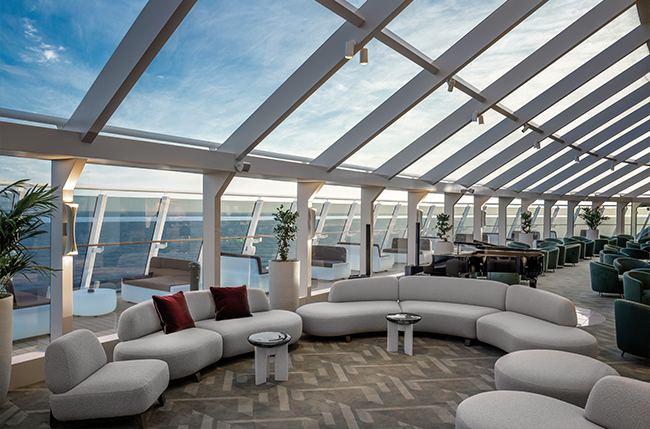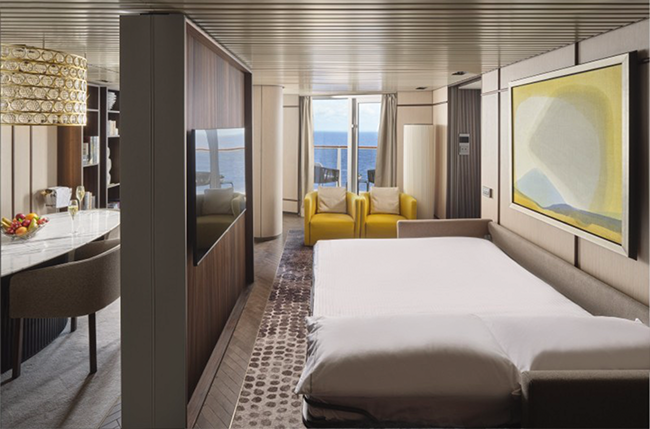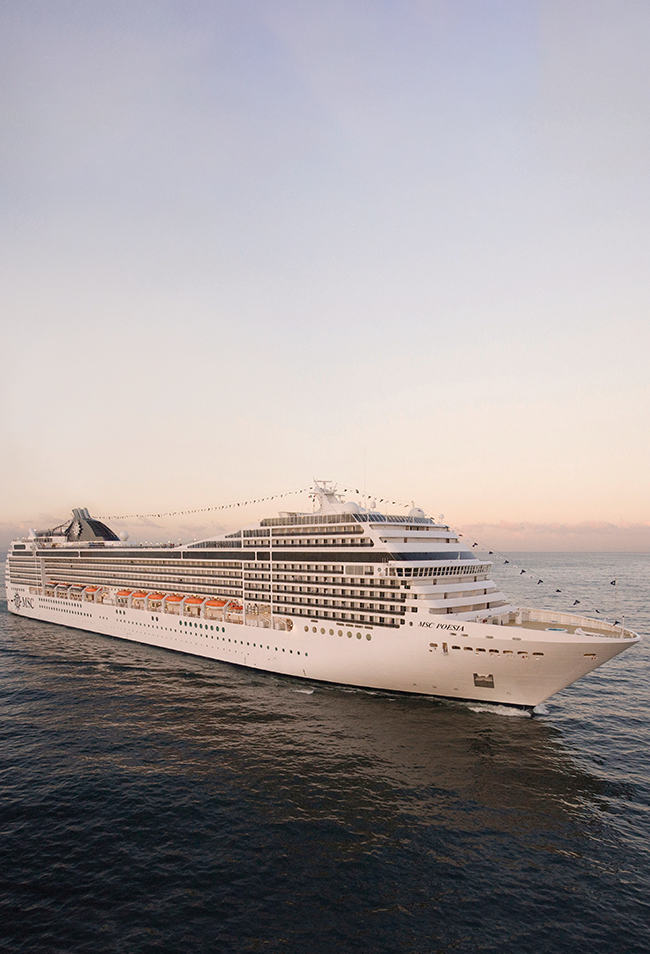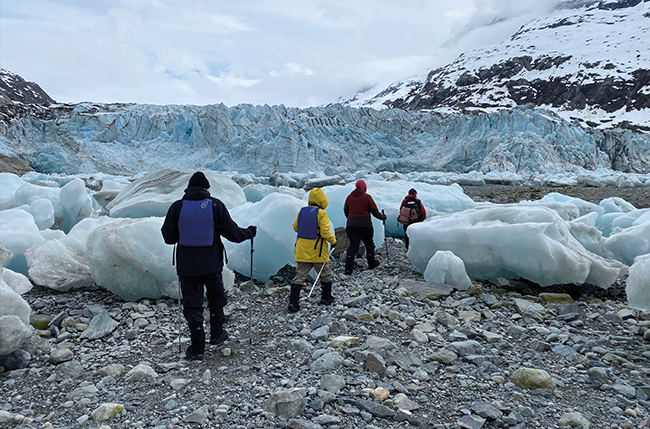Cruising has come back in a big way since the trauma of COVID, which devastated the industry. 2023 offers excellent opportunities for good-value expeditions across the globe, and canny travellers with a sense of adventure currently have the pick of the crop. Antarctica, the Amazon, the fjords or just a break from routine, there’s a tempting season of discovery to be had. The cliché Alaskan cruise is a gentle sail out of Seattle bound for the Inside Passage and the port of Juneau, Alaska’s capital, to buy an Inuit carving, see a whale if you’re lucky, and gaze at the far-off Haines glaciers over a bowl of warm-milk muesli. A much better bet, however, is AdventureSmith Explorations’ trip into Glacier Bay National Park aboard the 12-passenger Sea Wolf, a small ship that can negotiate the tiny inlets and bays of the extraordinary wilderness. The six-day trip begins at Icy Strait, a primordial rain forest, and heads down the east and then west arms of Glacier Bay.
Being a tiddler of a ship – crewed by local sailors – the itinerary is entirely malleable. Depending on the weather, a typical day will involve sailing into a bay such as Muir Inlet or North Sandy Cove, taking to the kayaks and paddling beyond where even the Sea Wolf can’t reach, then hitting land and hiking to any one of a number of glaciers, forests or wildlife zones (such as the puffin rookery at the Tarr Inlet). Being a national park, it’s protected from the most intrusive tourism and numbers are strictly monitored. The chances of seeing coastal brown bears, black bears and even the rare glacier bear are excellent.

That said, the Norwegian fjords are on most bucket lists and Norwegian Cruise Line does it remarkably well. On the Prima’s main deck, the town of Måløy disappears as the ship heads down the Sognefjord towards the village of Geiranger, hands down one of the most beautiful hamlets on earth, sitting in an ancient bay surrounded by towering cliffs. The waters darken to black, go still and glassy, and the 150 000 ton ship shrinks to the size of a bath toy as the narrowing corridor of rock squeezes out the sky. White waterfalls dissect the vertical rock walls and free-fall to the mirror surface below. It’s astonishing – look up, mouth open, feel as small as a minnow in the Gulf Stream. The fjords formed around 20 000 years ago during the previous ice age, when glaciers carved paths down to the sea along existing valleys. There are now more than 3 000 of them from Oslo to well above the 17th Parallel, but today most of the cruise ships head for just a handful in the southwest. Sognefjord is the most popular.

The Prima, one of NCL’s most celebrated ships, is a good fit – big enough to enjoy the time at sea, manoeuvrable enough to manage the fjords. It features an area called the Haven, a select zone with its own staterooms, restaurants, lounges and entertainment. Choose the Premier Owner’s Suite up there and the experience will be a memorable one, with three bedrooms and an outside tub standard. The latter is a perfect spot for watching the waterfalls glide by, Champagne in hand, not a care in the world.
(Much) further down south, Antarctica is a far less-visited wilderness than its northern brother, primarily because of the distance from most inhabited landmasses. The angry Southern Ocean is another barrier; unlike the quiet calm of the northern Pacific, the Atlantic is a raging scream of pitch and yore. This all means that mostly large liners make for Antarctica, which watch from a frustrating distance as the glaciers calf and the gentoo penguins are chased by the leopard seals. Not so for Oceanwide Expeditions’ Plancius, a 1D ice-going vessel that takes 114 passengers and can go where few other ships dare. The nine-day cruise begins in Ushuaia, at the southern tip of Argentina, and heads down the mirror-smooth Beagle Channel, before hitting the spin-drier Drake Passage (the infamous ‘Drake Shake’). After two days of turbulence the ship magically crosses the Antarctic Convergence into a serene wonderland of feeding whales, penguins, terns, albatross, seals and leopard seals, known as the circum-Antarctic up-welling zone.

Power on and hit Deception Island, a volcanic caldera, and sail right into it. It’s abandoned by man now but hosts hundreds of thousands of seabirds, including the world’s largest population of chinstrap penguins (and Robert Scott’s ghost town – he first saw the Antarctic continent from Deception). Then the Plancius makes for the Antarctic Peninsula, home to many country bases, the Jacques Cousteau Society base and a veritable bun fight of mating wildlife. During the voyage, passengers climb into zodiacs (inflatable boats) and explore the iceberg forests and tiny bays. Down the Neumayer Channel and close to Neko harbour, landfall is alongside the Neko glacier, popping gunshots as it makes its snail-pace way to the sea. The zodiacs also head for Pléneau Island with its stinky, moulting hordes of elephant seals and noisy humpbacks in the bay. Hiking through the tundra among the fragrant leviathans is a profoundly memorable experience.
For intrepid travellers who prefer the heat and wild factor turned up, there’s the untamed Amazon. Few sights in the world are as spectacular as the Amazon confluence, the so-called ‘meeting of the waters’ near Manaus. The humic acid waters of the Rio Negro and the silty, sandy waters of the Rio Solimöes create a Top Deck effect that stretches for kilometres. It is the central attraction of most Amazonian cruises and, as it’s only a few miles from the centre of Manaus, very popular. Many cruises end there, but Amazon Nature Tours do it properly – and ecologically soundly – taking the good ship Tucano up the Rio Negro tributary on a compelling voyage literally into the heart of the Amazon Basin, as the waterways split and filter into the teeming oxygen mass called the rain forest.

For the first three days, the boat heads north towards Colombia, stopping frequently for passengers to explore the forest on hour-long hikes to known spots to try spot capuchins, howlers, sloths, giant otters, tapirs and emerald boas. The trip ceilings out at the confluence of the Rio Jauaperi, after which it heads back down the southern bank of the Negro, stopping en route to Manaus at the meeting of the waters and at Lago Janauari Ecological Park, a waterlogged forest-scape where the wildlife literally, and quite overwhelmingly, grows on trees. It’s hard not to feel like Bogart or Hepburn in the African Queen – the boat looks the same (18-berth; shallow bow; high, wide decks) and the sliding wall of green is the same. But there are no mad locals, the food is way better, the air con works a treat, and the staff of eight are classy naturalists given to bouts of excited overshare at the sight of every sex-crazed caiman or blossoming clitoria amazonum.
The Mediterranean, on the other hand, is all about impossible blues and whites in the blazing sun, and for South Africans the ideal time to experience it is during our winter. Cue MSC’s Poesia, which leaves from Lisbon in September on one of the most intriguing Med cruises available. It’s the best of all worlds – a floating hotel that allows you to avoid all the irritating overland travelling, and an itinerary that takes in much of the oldest aspects of an ancient, multicultural region. It starts in that most astonishing of European capitals, and travellers would do well to arrive a few days early to explore the city of hills. Lisbon’s streets and viewpoints offer endless delight, a mix of traditional, contemporary and unexpected architecture and nightlife. From Lisbon, the 93 000-ton Poesia heads to the beaches of Spain’s Costa Brava, then on to Portofino in Italy, and finally Greece and Turkey, where it puts in at the ancient temple of Ephesus before heading on to Istanbul and back west to Athens. Eleven nights are plenty to explore as well as to relax; a good mix of time on board and time ashore, no rush or stress. Arguably the highlight of the trip is that visit to Ephesus, the 10th century BC city just outside Kuşadası. For centuries the site has been occupied by various conquerors, all leaving elements of varied architecture and culture behind. Most impressive are the gate of Augustus and the Library of Celsus.
MSC’s Poesia cruise ship is something of an achievement in itself. Built in 2008, it is one of the company’s smaller vessels, popular because of its manageable size. It’s the sister ship to the Musica and Orchestra, both well-known in SA waters. Choose one of 18 Aurea premium suites on the Alfieri deck to enjoy a stateroom with superb views over the bow of the ship, a balcony and a bathtub. The ship also has a tennis court, a wellness centre and three restaurants.
Harking back to the glamour days of trans-Atlantic cruises, when being on the ‘right’ crossing and being seen by the right people was everything, a new trend in cruise one-upmanship has taken the industry by storm. Celebrity voyages team big-name stars with theme cruises, attracting passengers who otherwise wouldn’t be caught dead on a floating Vegas knockoff. There are the flagrantly opportunistic – downwardly spiralling pop groups putting the finishing touches to their comeback album – to the downright weird – a Loveboat cruise complete with (surviving) cast members – but it’s the Queen Mary 2 that shows how it’s really done. Of its seven-night trans-Atlantic trips this year, most are subtly themed in keeping with the ship’s grand dame status. Highlights will be the August cruise with the English National Ballet, as well as a Literary Festival in November, with an enviable programme of guest speakers including Kate Mosse, Alan Titchmarsh, Val McDermid and Richard Osman.
Besides the wit, there’s obviously the fun of being on the longest (though not the largest) liner in the world, with the most Champagne, sharpest dressers, largest ballroom and the greatest views of New York, as it powers past Lady Liberty. And, of course, traditional afternoon tea in the Queens Room with scones, cream and strawberry jam. Oh so lah-dee-dah.









